When venturing into the realm of luxury electric vehicles, the Lucid Air stands as a paragon of innovation and splendor. Yet, a discerning buyer or investor must consider not just the allure of the vehicle but its financial implications over time.
The concept of Lucid Air depreciation is a critical factor to observe, particularly for those calculating the long-term return on this high-end EV investment. With an impressive array of features and capabilities, the Lucid Air’s resale value is a reflection of its standing in the demanding EV market, paired with the industry’s focus on value retention.
As sleek as it is powerful, the Lucid Air expresses a depreciation rate to be noted. Holding a remarkable score of 6.5 out of 10 in retained value and a calculated 5-year depreciation of 0.656891, it provides a glimpse into the vehicle’s fiscal journey. Understanding its stance in the market requires a deep dive into these figures, comprehending how the Lucid Air maintains its worth in the bustling sphere of luxury electric vehicles.
Key Takeaways
- The Lucid Air is a luxury electric vehicle with a significant impact on the modern transportation landscape.
- Examining the Lucid Air depreciation rate offers insights into its long-term financial performance.
- A 5-year depreciation score of 0.656891 indicates moderate value retention for the Lucid Air within the EV market.
- With a retained value score of 6.5 out of 10, the Lucid Air remains a competitive player in the luxury EV segment.
- Understanding the depreciation and resale trends is essential for current and prospective Lucid Air owners and investors.
Understanding Lucid Air Depreciation
In the dynamic landscape of electric vehicles, understanding the intricacies of a car’s value over time is essential for both current owners and prospective buyers. The Lucid Air, a beacon of luxury and innovation within the EV arena, is not immune to the financial phenomenon of depreciation. In our analysis, we delve into the key elements that shape the Lucid Air trade-in value and influence its depreciation analysis.
Factors Influencing Lucid Air Value Retention
At first glance, the Lucid Air captures the imagination with its elegant design and cutting-edge performance. However, its value retention is governed by a myriad of factors beyond aesthetics. Warranty terms, often a buyer’s safety net, play a significant role; with the Lucid Air’s warranty covering 4 years or 50,000 miles for bumper-to-bumper, and a reassuring 8 years or 100,000 miles for the powertrain.
Battery technology, representing the heart of any EV, also dictates longevity and efficiency, impacting the EV depreciation curve. The initial asking price sets the stage for future resale values, and the market competition keeps it in check—pushing innovation while warming the shadow of depreciation over the years ahead.
How Lucid Air Depreciates Over Time
As with all vehicles, the passage of time etches into the marketability of the Lucid Air. However, this luxury EV’s journey through depreciation takes on unique contours, molded by the ever-advancing EV technological landscape. Analyzing its depreciation trajectory sheds light on its enduring quality and the evolving market perception.
Comparing Lucid Air Depreciation to Other Luxury EVs
Compared to its contemporaries, such as the illustrious Tesla Model S and the bold Audi e-tron GT, the Lucid Air charts a competitive depreciation path. With a 5-year depreciation score of 0.656891, it glides closely behind the Tesla’s respectable 0.522578, while outperforming the Audi e-tron GT’s steeper rate of 0.694154. Luxury vehicle depreciation often stirs anxiety in investor circles, yet the Lucid Air maintains composure, promising a future of potential in the luxury EV market.
Lucid Air’s Position in the EV Market
The electric vehicle (EV) horizon is witnessing a formidable contender in the form of Lucid Air, whose market presence is underscored by market share expansion and intensifying demand.
As consumers increasingly flock towards electric cars, the Lucid Air has carved out a substantial niche for itself based on a fusion of luxuriousness and pioneering technology. This section will explore the various facets of the Lucid Air’s market prowess and why it is becoming a desirable option in the EV industry.
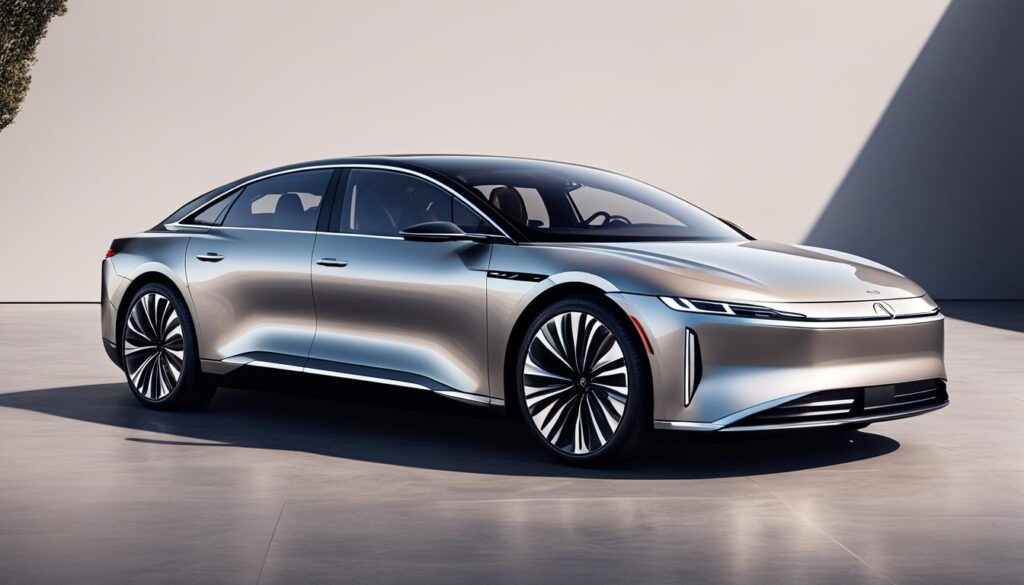
The Demand for Lucid Air Models
With electric cars demand surging, Lucid Motors has responded by offering an EV that not only meets but surpasses expectations. The allure is palpable—the Lucid Air boasts of a spacious interior and driving comfort, pulling ahead in the competitive race.
Featuring an industry-leading range and unrivaled cargo space, it appeals to a market segment that refuses to compromise on indulgence or practicality. The Lucid Air’s competitive edge is indeed a force that is reshaping consumer preferences in the EV landscape.
Lucid Air’s Market Share and Competitiveness
Lucid Air’s market share continues to grow as it makes its impress upon the luxury electric midsize car sector. Aided by its formidable drivetrain, which delivers an impressive 430 horsepower, and an outstanding range of 419 miles, the Lucid Air stands as a testament to Lucid Motors’ commitment to quality and performance.
This section delves into how the sophisticated features and forward-thinking design have cemented Lucid Air’s status as a formidable opponent in the race for EV market dominance.
| Lucid Air Feature | Market Impact |
|---|---|
| Horsepower (hp) | Enhances performance competitiveness |
| Range (miles) | Strengthens market positioning for long-haul EV consumers |
| Cargo Space (cubic feet) | Positions as a practical offering in the luxury EV segment |
| Interior Dimensions (cubic feet) | Lends an edge in the premium car market |
| 5-Year Depreciation Score | Signifies reasonable value retention in luxury EV class |
Leveraging these competitive advantages, Lucid Air is poised for strengthening its grasp on the EV market. Its fusion of demand-driven features and tangible market metrics like range and horsepower has fostered an environment where the Lucid Air is not just competing, but leading on multiple fronts. As the tides of the EV market trends swell, Lucid Air’s competitiveness is an intriguing highlight in the ongoing narrative of electric mobility.
The Impact of Mileage on Lucid Air Depreciation
One cannot discuss the dynamics of Lucid Air vehicle depreciation without considering the influence of mileage. Common to the auto industry, higher mileage typically equates to a greater degree of vehicle wear and tear, which in turn accelerates decrease in value.
For potential Lucid Air owners, it’s paramount to understand that mileage impact could play a substantial role in the vehicle’s eventual resale price, even though concrete statistics on mileage specific to the Lucid Air’s depreciation are not directly available. To highlight the general trend affecting EVs like the Lucid Air, let’s examine how mileage can affect resale values among luxury electric vehicles.
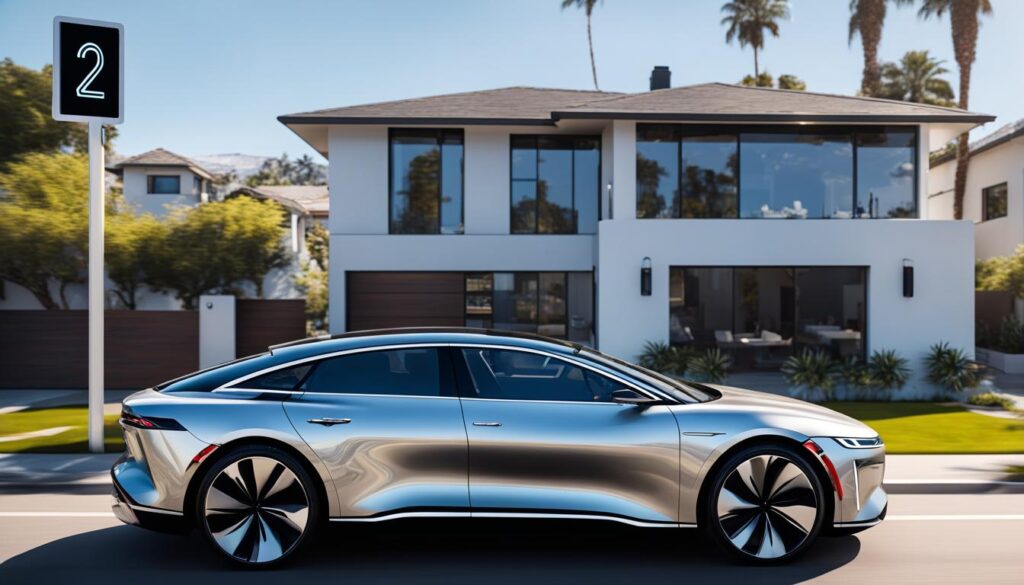
Generally, electric vehicles are lauded for fewer moving parts requiring less maintenance compared to traditional combustion engine vehicles. However, despite this advantage, the accumulated distance traveled inevitably affects each car’s appeal to future buyers.
On the surface, what this can lead to for a Lucid Air owner is a more pronounced contrast between high-mileage models and those with fewer miles on the odometer when it comes to resale conditions and valuation.
- Lower mileage Lucid Airs tend to retain more of their original value, appealing to buyers looking for a like-new experience without the premium price of a brand-new vehicle.
- As mileage increases, various factors such as battery longevity and overall vehicle performance come into sharper focus for the used car buyer, potentially steering them towards lower-priced alternatives or those with a track record for endurance.
While the specifics of how mileage impacts the Lucid Air’s depreciation rate are not explicitly outlined in available data, observing industry trends provides a representation. The longevity of the electric battery, the condition of the vehicle’s exterior and interior, and the technology onboard are all assessed more critically as mileage climbs.
Consumers recognize that these elements, when considered in conjunction with a vehicle’s mileage, often paint an accurate picture of its history and future performance.
In summary, while it’s essential for current and future Lucid Air owners to consider that high mileage may equate to a steeper depreciation curve, it’s equally important to remember the inherent quality and innovation of the Lucid Air as factors that might mitigate such impacts.
Prospective buyers and sellers should weigh these considerations carefully when deciphering the resale value of a Lucid Air and determine how its accrued mileage reflects the overall condition and anticipated performance of the vehicle.
Lucid Air Resale Value Analysis
The journey of the Lucid Air through its life as a vehicle not only involves revolutionizing electric transportation but also maintaining its monetary worth in the competitive resale market. Critical to this is the understanding of Lucid Air resale value trends, which offer potential insights into the vehicle’s enduring appeal and fiscal viability in the pre-owned market sector.
Resale Price Trends for Lucid Air
Keeping a pulse on the Lucid Air’s depreciation narrative reveals key indicators of its resale prowess. The current 5-year depreciation score of 0.656891, albeit moderately high, suggests that while Lucid Air depreciates, it does so with resilience, which speaks to its build quality and consumer desire. Furthermore, its high retained value rating hints at a steadfast demand among luxury electric vehicle enthusiasts.
Projected Resale Values Based on Current Data
When considering future resale values of the Lucid Air, market analysts often turn to current depreciation patterns as a logical starting point. By extrapolating the existing data, it’s anticipated that the Lucid Air will likely sustain a competitive position within the luxury EV resale market, especially as it garners praise for its technological refinement and luxury credentials.
However, projected resale values for the Lucid Air are not without their contingencies and are influenced by a myriad of factors, including:
- Technological innovations that could enhance or outmoded current models
- The global economic landscape influencing purchasing power
- Industry-wide shifts towards more sustainable and efficient battery technologies
Each of these considerations stands to augment or diminish the Lucid Air’s future financial valuations. Nevertheless, prospective buyers remain vigilant of such trends, often resulting in a watched and calculated approach towards resale market participation.
| Factor | Influence on Resale Value |
|---|---|
| 5-Year Depreciation Score | Moderate depreciation positions it as a good long-term investment within its class |
| Retained Value Rating | High desirability potentially slows depreciation rate |
| Technological Advancements | Can either bolster value with relevance or detract when newer features become standard |
| Economic Climate | Global financial changes can impact luxury EV affordability and desirability |
| Market Demand | Interest in sustainable luxury vehicles supports stronger resale values |
Ultimately, the portrait painted by the Lucid Air’s resale and depreciation metrics is one of guarded optimism, with buyers and sellers alike keen on the promise of what future market factors will bring to the forefront of luxury electric vehicle ownership.
How Warranty and Reliability Affect Lucid Air Value
As an aspirant in the expanding electric vehicle market, the Lucid Air is quickly becoming a symbol of premium electric mobility. A key attribute that influences consumer confidence and hence its value retention, is the warranty offered by Lucid Motors. Here we explore warranty impact, reliability, and depreciation factors that play substantial roles in determining the long-term financial appeal of the Lucid Air.
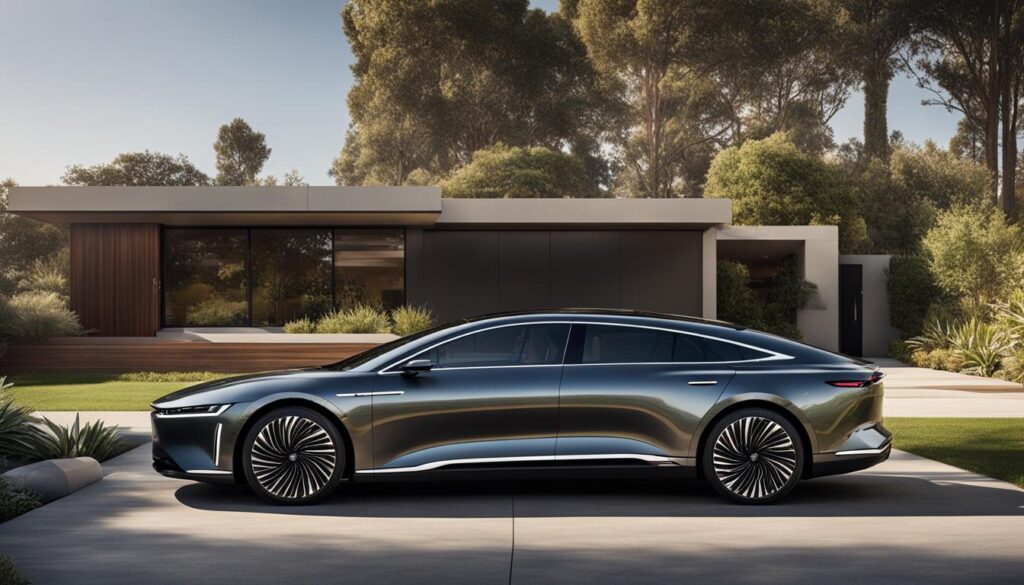
A comprehensive warranty has become an essential aspect for luxury vehicles, more so for those powered by electricity. The Lucid Air’s coverage spans 4 years or 50,000 miles for bumper-to-bumper, and an extended 8 years or 100,000 miles for the powertrain. This generous warranty serves as a testament to the vehicle’s build quality and reflects the manufacturer’s confidence, impacting the Lucid Air’s value retention positively.
Perceived reliability of the Lucid Air is another linchpin that upholds its value over time. In the absence of long-term reliability data, prospective buyers rely heavily on warranty duration as a proxy for vehicle trustworthiness, which inevitably influences depreciation rates. The lengthier the warranty, particularly covering crucial components like the battery and electric motors, the more peace of mind a buyer gains.
| Factor | Impact on Lucid Air Resale Value |
|---|---|
| Bumper-to-Bumper Warranty | Enhances buyer confidence in short-term vehicle quality |
| Powertrain Warranty | Protects against major repair costs, boosting long-term value |
| Battery Longevity | Crucial in determining EV reliability and sustaining resale price |
| Brand Perception of Quality | Builds the narrative of durability and satisfaction |
| Depreciation Rate | Affects the attractiveness of the car as a pre-owned purchase |
The Lucid Air’s depreciation, like all vehicles, doesn’t solely rest on its warranty and reliability. Other influential variables include market reception, technological advancements, and the general shift towards electric vehicles.
However, understanding warranty impact and reliability helps to provide us with a clear lens through which to gauge the Lucid Air’s enduring allure and financial prudence for those eyeing the electric luxury market.
In conclusion, the Lucid Air’s extended warranty and the anticipated reliability elevate the vehicle into an esteemed position amongst luxury electric cars, allaying concerns of future repairs and buffering against swift depreciation—an assuring factor for current and potential owners alike.
Tech Upgrades and Their Effect on Lucid Air Vehicle Depreciation
The electric vehicle market is rapidly evolving, with advancements in technology significantly impacting the depreciation rates of luxury EVs like the Lucid Air. Innovations in battery technology, infotainment systems, and autonomous driving features not only enhance user experience but also play a vital role in determining the resale value of these vehicles. Let’s delve into how such tech upgrades can affect Lucid Air depreciation rate over time.
The Role of Battery Technology Evolution
Lucid Air’s cutting-edge battery technology is a significant factor behind its impressive performance metrics. However, the speed at which battery innovation is moving could also affect the car’s future valuation. As newer, more efficient batteries are developed, the older models may seem less desirable. Battery technology evolution can thus lead to a faster depreciation rate for previous iterations of electric vehicles.
Despite this, Lucid Motors has engineered its batteries for longevity and efficiency, aiming to minimize the impact of technological advancements on the Lucid Air depreciation rate. Yet, the longevity and health of the battery remain at the forefront for buyers in the used electric vehicle market.
Infotainment and Autonomy Features’ Impact on Resale
Lucid Air’s sophisticated infotainment systems are designed to offer a seamless and intuitive user experience, boasting features that are central to the luxury EV’s allure. The presence and condition of these systems can either enhance the resale value or, when lacking in comparison to newer models, detract from it.
The inclusion of advanced autonomous driving features similarly influences the Lucid Air’s appeal on the secondary market. As such technology continues to develop, the demand for up-to-date and high-functioning autonomous systems significantly affects resale values. Vehicles equipped with the latest autonomous capabilities are naturally poised to command higher resale prices.
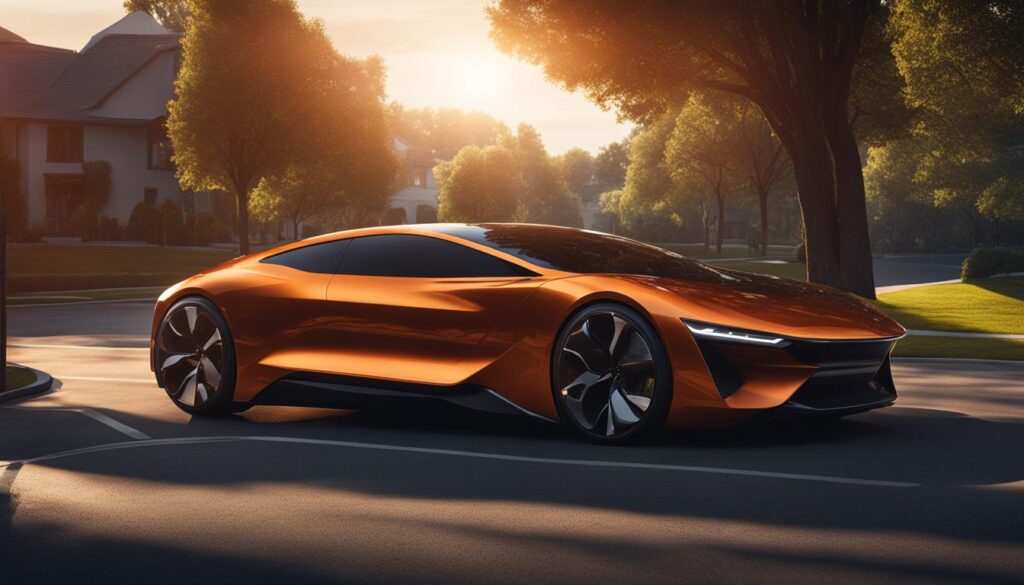
Overall, as tech features like updated infotainment systems and autonomous driving capabilities continue to evolve, the Lucid Air must stay abreast of these trends to sustain its value. Buyers will remain enthusiastic about purchasing a used Lucid Air if it continues to incorporate cutting-edge technology that keeps pace with, or even exceeds, current market expectations.
Lucid Air Trade-in Value Considerations
Entering the market with thoughts of maximizing Lucid Air trade-in value necessitates a strategic approach. For owners contemplating a trade, the convergence of vehicle readiness and market timing presents a prime opportunity to optimize value. Factors influencing trade-in offers for Lucid Air include condition, mileage, and prevailing market demands. Awareness of these elements and keen market timing are key to seizing the best trade-in offers available.
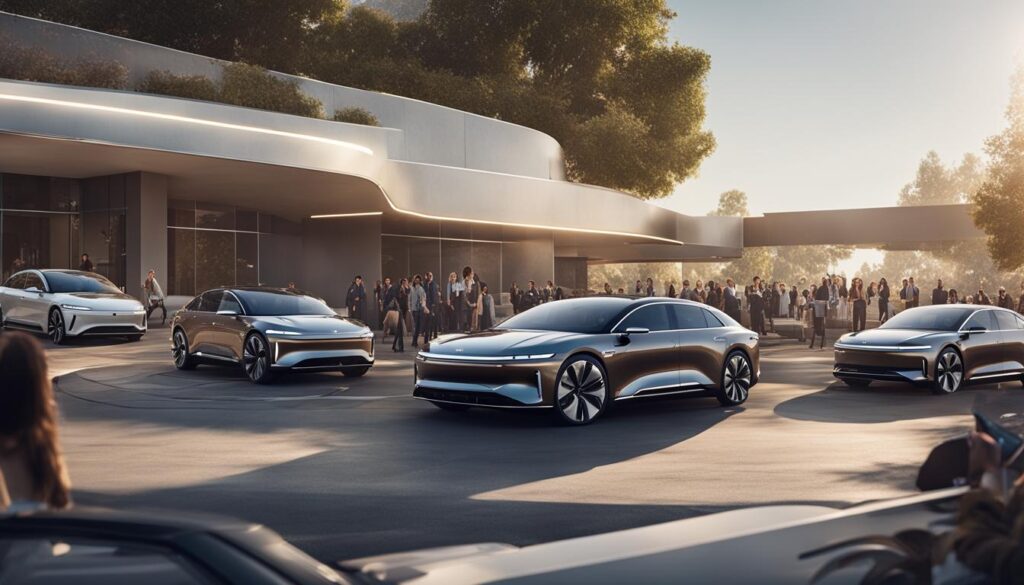
Best Practices for Maximizing Lucid Air Trade-in Offers
Enhancing the trade-in offer for your Lucid Air involves a few well-defined practices. Ensure your vehicle is in impeccable condition, with all necessary maintenance completed and documented. Presentation is vital; a clean and well-maintained vehicle makes a strong impression. Additionally, understanding the vehicle’s worth through research, and even obtaining multiple trade-in evaluations, can provide leverage in negotiations.
Timing the Market: When to Trade in Your Lucid Air
For optimal trade-in offers, timing can be just as crucial as the vehicle’s condition. Trade in your Lucid Air when demand surges but inventory is tight—periods typically observed during model year changes or when manufacturer incentives are low. Monitoring EV market trends and predicting shifts can help you determine when your Lucid Air is most likely to yield the highest trade-in value.
How External Factors Influence Lucid Air Vehicle Depreciation
The Lucid Air, an embodiment of electric luxury and sophistication, faces depreciation influences not solely confined within its sleek contours or cutting-edge technology. Instead, depreciation, an inevitable aspect of automotive economics, is significantly shaped by external factors. Such elements extend from policy frameworks to macroeconomic dynamics, often acting beyond the control of automakers and consumers alike.
Government incentives serve as a powerful catalyst in propelling the popularity of electric vehicles. Tax credits, rebates, and subsidies extended to EV purchasers directly contribute to the increased initial affordability, therefore impacting the pre-owned market. When these incentives are rolled back or expire, they can precipitate a decline in the demand for used models, including the Lucid Air, potentially precipitating increased depreciation rates.
The advancement and availability of charging infrastructure are inexorably linked to EV desirability. The Lucid Air’s allure is magnified in locales where the charging network is dense and technologically advanced, thus safeguarding its value.
Conversely, in regions lagging in infrastructure development, potential buyers could be dissuaded, fearing range limitations and inconvenience, thereby hastening the vehicle’s depreciation.
Fuel prices dance in tandem with EV desirability—rising gasoline costs heighten the appeal of owning an electric vehicle like the Lucid Air. As operating an EV becomes more economically viable in contrast to traditional combustion engines, the EV market enjoys fortified demand, which can temper depreciation rates.
Economic fluctuations also cast wide ripples across the EV market. In times of economic downturn, luxury items are often the first to be forsaken, which can unfavorably swing Lucid Air’s depreciation curve. Yet, in economic upturns, luxury electric vehicles may bask in greater demand, offering some buoyancy against depreciation.
| External Factor | Impact on EV Depreciation |
|---|---|
| Government Incentives | Reduce initial purchase price, affecting later resale value |
| Charging Infrastructure | Enhances or decreases appeal based on availability and technology |
| Fuel Prices | Higher prices drive demand for EVs, potentially reducing depreciation |
| Economic Fluctuations | Can either depress or stimulate the luxury EV market |
Competitors in the luxury EV space, predominantly Tesla, set proactive pricing strategies that reverberate throughout the pre-owned market. Notably, Tesla’s consistent price adjustments directly challenge the Lucid Air’s standing. When new EVs become more accessible price-wise, this propensity can cause the demand for used models to taper, contributing towards an accelerated depreciation for vehicles like the Lucid Air.
Ultimately, observers and stakeholders within the EV sphere must acknowledge that although the intrinsic qualities of the Lucid Air are substantial, the external factors remain pivotal in shaping its EV depreciation influences. The dance between market forces and automotive industry will continue to define the fiscal fate of luxury electric vehicles.
The Role of Market Trends in Lucid Air Depreciation
It’s no secret that market trends play a pivotal role in shaping the electric vehicle market trends, influencing everything from consumer behavior to resale values. Specifically, trends surrounding EV incentives and varying gas prices can significantly affect the depreciation of luxury electric cars such as the Lucid Air.
Delving into these aspects can provide valuable insights for both current and potential Lucid Air owners, as well as industry enthusiasts. In this context, understanding the interplay between these trends and EV depreciation is becoming increasingly important.
Electric Vehicle Incentives and Their Impact
The introduction and evolution of government-backed EV incentives have indelibly altered the desirability and cost-effectiveness of owning an electric vehicle. These financial incentives are designed to mitigate the often higher initial purchase price of EVs, making them more accessible to the broader public. However, when considering the resale value of a luxury electric vehicle like the Lucid Air, we must consider how these incentives might affect its Lucid Air depreciation profile over time.
As new models hit the market, coupled with sweetened incentive packages, the secondary market finds itself adjusting. The result is a potential change in used vehicle prices, as the availability of incentives for new models may render used EVs, including the Lucid Air, a less attractive proposition. Understanding these market dynamics is crucial for those looking to forecast depreciation trends or contemplate topline investment decisions within the EV sphere.
Gas Prices and the Shift to Electric Vehicles
The escalating cost of gasoline is an impetus driving more consumers towards electric transportation. As fuel prices climb, the economics of owning a Lucid Air or other electric vehicles become more compelling. In regions where gas prices maintain upward trajectories, the market sees a corresponding uptick in electric vehicle adoption, thereby influencing demand and subsequently, the depreciation of EVs like the Lucid Air.
But it’s not all a one-way street. While rising gas prices can bolster the attraction towards EVs, resulting in a potentially less rapid depreciation, market saturation and subsequent competition amongst electric vehicles can also emerge.
As more manufacturers expand their EV offerings, market competition can sharpen, possibly leading to aggressive pricing strategies, which may alter the residual values for existing EVs. A watchful eye on fuel trends coupled with market saturation levels thus becomes key to predicting the Lucid Air’s positioning in the resale hierarchy.
As the electric vehicle market matures, these factors – EV incentives and gas price fluctuations – remain prominent shapers of Lucid Air’s value over time. By staying abreast of market trends and regulatory changes, stakeholders can navigate the complexities of depreciation, ensuring strategies are as dynamic and charged as the vehicles themselves.
Conclusion: Lucid Air’s Depreciation and Market Trajectory
Through a detailed exploration of the factors influencing its financial journey, the Lucid Air stands out in the luxury electric vehicle (EV) market with notable depreciation insights. Various elements such as technological upgrades, market dynamics, and warranty coverage shape the Lucid Air’s resale value. Having delved into these aspects, we can now synthesize key takeaways and project the Lucid Air future outlook within an evolving marketplace.
Key Takeaways on Lucid Air Depreciation and Resale Value
The depreciation and resale value of the Lucid Air are shaped by its retained value score, the progressive 5-year depreciation score, and the high benchmarks it sets in cargo space and range. These factors, combined with its extensive warranty and reliability, contribute to the Lucid Air’s standing as a valuable contender in its segment.
Market position is pivotal; despite the presence of formidable players like Tesla, Lucid Air has carved a niche for itself, showcasing moderate depreciation and solid value retention within the luxury EV class.
Future Outlook: What to Expect from Lucid Air’s Market Position
Looking ahead, the Lucid Air future outlook appears promising, contingent on its ability to navigate the terrain of emerging EV technologies and shifting consumer preferences. Keeping pace with advancements and maintaining a competitive edge in technology will be crucial to its market position.
As this upscale EV marque forges ahead, potential buyers, investors, and enthusiasts will be watching closely to see how the Lucid Air sustains its allure and economic viability in a landscape that’s accelerating towards an electric future.
FAQ
What factors influence the Lucid Air’s depreciation and value retention?
Several factors that affect the Lucid Air’s value retention and depreciation include warranty terms, battery technology, the original asking price, market competition, and the rapid evolution of the EV market and its technologies.
How does the depreciation rate of the Lucid Air compare to other luxury electric vehicles?
The Lucid Air’s 5-year depreciation score is competitive within the luxury EV market, though it is higher than the Tesla Model S and lower than the Audi e-tron GT. These figures reflect the intricacies of the market and the positioning of each brand.
How does mileage affect the Lucid Air’s depreciation?
Mileage plays a significant role in the depreciation of the Lucid Air, with higher mileage likely leading to a steeper depreciation curve and a negative impact on the resale value, similar to other luxury vehicles.
Can you provide insights into the Lucid Air’s resale value trends?
While specific future resale values aren’t provided, the current data indicates that the Lucid Air’s resale value trends can be extrapolated from its 5-year depreciation score. The projected resale trends will also be influenced by market demand and technological advancements.
What is the warranty coverage for the Lucid Air, and how does it affect its resale value?
The Lucid Air comes with a 4-year or 50,000-mile bumper-to-bumper warranty and an 8-year or 100,000-mile powertrain warranty. A robust warranty coverage can strengthen resale value by assuring potential buyers about the vehicle’s reliability and the confidence of the manufacturer in their product.
How do tech upgrades impact the depreciation of the Lucid Air?
Technological advancements, especially in battery and infotainment systems, significantly impact electric vehicle depreciation. The evolution of these technologies may affect the desirability of older Lucid Air models, thereby influencing future resale values.
What are some best practices for maximizing the trade-in value of a Lucid Air?
To maximize trade-in value, it’s important to maintain the vehicle well, be aware of market trends, and choose a time when demand is high but supply is limited. Keeping the mileage low can also help preserve value.
What external factors influence the depreciation of the Lucid Air?
External factors affecting the Lucid Air’s depreciation include government incentives for EVs, development of charging infrastructure, fluctuations in fuel prices, economic conditions, and competitor pricing strategies.
How do market trends affect Lucid Air depreciation?
Market trends such as electric vehicle incentives and shifts in fuel prices influence the demand for electric vehicles. As incentives increase and fuel prices rise, there might be a higher demand for EVs like the Lucid Air, affecting depreciation.
